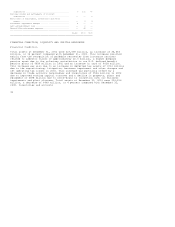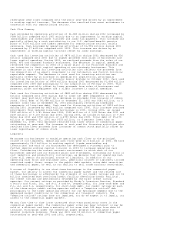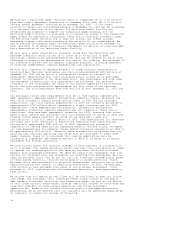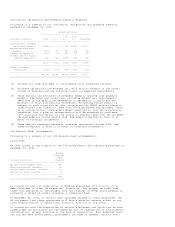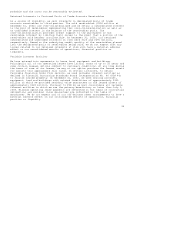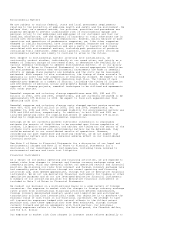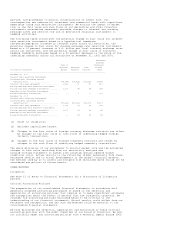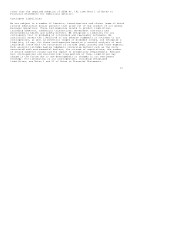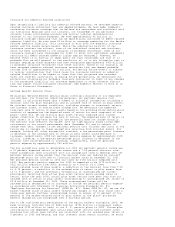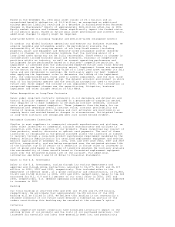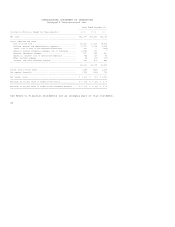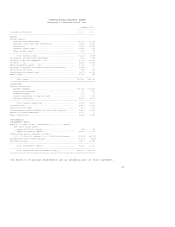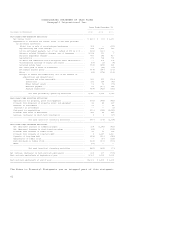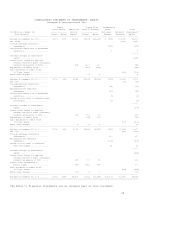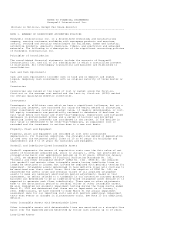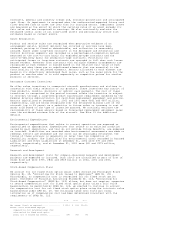Honeywell 2002 Annual Report Download - page 228
Download and view the complete annual report
Please find page 228 of the 2002 Honeywell annual report below. You can navigate through the pages in the report by either clicking on the pages listed below, or by using the keyword search tool below to find specific information within the annual report.Insurance for Asbestos Related Liabilities
Upon recognizing a liability for asbestos related matters, we recorded asbestos
related insurance recoveries that are deemed probable. We have made judgments
concerning insurance coverage that we believe are reasonable and consistent with
our historical dealings with our insurers, our knowledge of any pertinent
solvency issues surrounding insurers and various judicial determinations
relevant to our insurance programs. We have approximately $2 billion in
insurance coverage remaining that can be specifically allocated to NARCO related
asbestos liability. We also have $2 billion in coverage remaining for the Bendix
related asbestos liability. This insurance is with both the domestic insurance
market and the London excess market. While the substantial majority of our
insurance carriers are solvent, some of our individual carriers are insolvent,
which has been considered in our analysis of probable recoveries. Some of our
insurance carriers have challenged our right to enter into settlement agreements
resolving all NARCO related asbestos claims against Honeywell. However, we
believe there is no factual or legal basis for such challenges and that it is
probable that we will prevail in the resolution of, or in any litigation that is
brought regarding these disputes and have recognized approximately $900 million
in probable insurance recoveries from these carriers. Based on our analysis, we
have recorded asbestos related insurance recoveries that are deemed probable
through 2018 of approximately $2.0 billion. Projecting future events is subject
to various uncertainties that could cause the insurance recovery on asbestos
related liabilities to be higher or lower than that projected and recorded.
Given the inherent uncertainty in making future projections, we reevaluate our
projections concerning our probable insurance recoveries in light of any changes
to the projected liability, our recovery experience or other relevant factors
that may impact future insurance recoveries. See Asbestos Matters in Note 21 of
Notes to Financial Statements.
Defined Benefit Pension Plans
We maintain defined benefit pension plans covering a majority of our employees
and retirees. For financial reporting purposes, net periodic pension cost
(income) is calculated based upon a number of actuarial assumptions including a
discount rate for plan obligations and an assumed rate of return on plan assets.
We consider current market conditions, including changes in investment returns
and interest rates, in making these assumptions. We determine the expected
long-term rate of return on plan assets based on the building block method which
consists of aggregating the expected rates of return for each component of the
plans' asset mix. We use historic plan asset returns combined with current
market conditions to estimate the rate of return. The expected rate of return on
plan assets is a long-term assumption and generally does not change annually.
The discount rate reflects the market rate for high-quality fixed income debt
instruments on our annual measurement date (December 31) and is subject to
change each year. Changes in net periodic pension cost (income) may occur in the
future due to changes in these assumptions resulting from economic events. For
example, holding all other assumptions constant, a one percentage point increase
or decrease in the assumed rate of return on plan assets would decrease or
increase, respectively, 2003 net periodic pension expense by approximately $100
million. Likewise, a one-quarter percentage point increase or decrease in the
discount rate would decrease or increase, respectively, 2003 net periodic
pension expense by approximately $40 million.
The key assumptions used in developing our 2002 net periodic pension income was
a 10 percent expected return on plan assets and a 7.25 percent discount rate.
These assumptions were consistent with our assumptions used to develop 2001 net
periodic pension income except that the discount rate was reduced by one-half
percentage point for 2002 due to financial market rates at December 31, 2001.
Net periodic pension income in 2002 was lower by $163 million compared with
2001. Net periodic pension expense for 2003 is expected to be $174 million, a
$321 million reduction from 2002, primarily as a result of a lower
market-related value of plan assets, a reduction in the discount rate from 7.25
to 6.75 percent, a reduction in the assumed rate of return on plan assets from
10 to 9 percent, and the systematic recognition of unrecognized net losses
principally resulting from actual plan asset returns below assumed rates of
return. Since the year 2000, actual plan asset returns have been less than our
assumed rate of return on plan assets contributing to unrecognized net losses of
$3.8 billion at December 31, 2002. These unrecognized losses will be
systematically recognized as an increase in future net periodic pension expense
in accordance with Statement of Financial Accounting Standards No. 87,
"Employers Accounting for Pensions" (SFAS No. 87). Under SFAS No. 87, we use the
market-related value of plan assets reflecting changes in the fair value over a
three-year period. Further, unrecognized losses in excess of 10 percent of the
greater of the market-related value of plan assets or the plans' projected
benefit obligation are recognized over a six-year period.
Due to the continued poor performance of the equity markets throughout 2002, we
made voluntary contributions of $830 million ($700 million in Honeywell common
stock and $130 million in cash) to our U. S. pension plans in 2002. Future plan
contributions are dependent upon actual plan asset returns and interest rates.
Assuming that actual plan returns are consistent with our assumed plan return of
9 percent in 2003 and beyond, and that interest rates remain constant, we would


